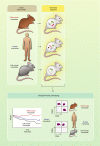Understanding immune-microbiota interactions in the intestine
- PMID: 31777071
- PMCID: PMC6904641
- DOI: 10.1111/imm.13150
Understanding immune-microbiota interactions in the intestine
Abstract
The past two decades have seen an explosion in research that aims to understand how the dynamic interplay with the gut microbiota impacts host health and disease, establishing a role for the gut microbiota in a plethora of pathologies. Understanding how health-promoting microbiota are established and how beneficial host-microbiota interactions are maintained is of immense biomedical importance. Despite the enormous progress that has been made, our knowledge of the specific microbiota members that mediate these effects and the mechanisms underlying these interactions is rudimentary. The dearth of information regarding the nature of advantageous host-microbiota interactions, and the factors that cause these relationships to go awry, has hampered our ability to realize the therapeutic potential of the microbiota. Here we discuss key issues that limit current knowledge and describe a path forwards to improving our understanding of the contributions of the microbiota to host health.
Keywords: immune homeostasis; microbiome; microbiota; mucosal immunology; tolerance.
© 2019 John Wiley & Sons Ltd.
Figures


References
-
- Hooper LV, Midtvedt T, Gordon JI. How host–microbial interactions shape the nutrient environment of the mammalian intestine. Annu Rev Nutr 2002; 22:283–307. - PubMed
-
- Smith K, McCoy KD, Macpherson AJ. Use of axenic animals in studying the adaptation of mammals to their commensal intestinal microbiota. Semin Immunol 2007; 19:59–69. - PubMed
-
- Orcutt RP, Gianni FJ, Judge RJ. Development of an Altered Schaedler Flora for Nci gnotobiotic rodents. Microecol Ther 1987; 17:59.
-
- Reyniers JA, Sacksteder MR. The use of germfree animals and techniques in the search for unknown etiological agents. Ann N Y Acad Sci 1958; 73:344–56. - PubMed
Publication types
MeSH terms
Grants and funding
LinkOut - more resources
Full Text Sources
Medical
Miscellaneous

